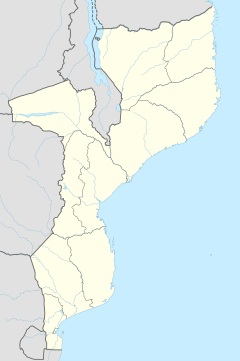Lichinga
| Lichinga | |
|---|---|
| Coordinates: 13°18′46″S 35°14′26″E / 13.31278°S 35.24056°E | |
| Country |
|
| Provinces | Niassa Province |
| Area | |
| • Total | 280 km2 (110 sq mi) |
| Elevation | 1,398 m (4,587 ft) |
| Population (2007 census) | |
| • Total | 142,253 |
| • Density | 510/km2 (1,300/sq mi) |
| Time zone | Central Africa Time (UTC+2) |
Lichinga is the capital city of Niassa Province of Mozambique. It lies on the Lichinga Plateau at an altitude of 1360 metres, east of Lake Niassa (Lake Malawi). The town was founded as Vila Cabral as a farming and military settlement. It is served by Lichinga Airport.
Founded by the Portuguese in 1931 as Vila Cabral, the town was designed to become a fast growth urban centre, its streets and avenues paying attention to a projected future growth. Vila Cabral was upgraded to city status in 1962. In the early 1960s its population was 27,000 inhabitants; by 1970 it had 36,715. The city developed as an agriculture and colonial service centre until the independence of Mozambique from Portugal in 1975. In addtition, the town's economy included forestry-based activities and was surrounded by a pine tree plantation, which still remains there.
After independence the new government renamed the city Lichinga. The effects of 17 years of civil war (1975-1992) spread famine and disease in Mozambique resulting in many deaths and refugees in the region around Lichinga.
Owing to its high altitude location the town experiences a moderate subtropical highland climate (Cwb, according to the Köppen climate classification), with cool weather in the dry season (May to September) and average temperatures of 15.5 oC in July. Summertime is October to April with the hottest weather in November: average temperature 22 oC. This is also the season of heavy rain especially December to March. The annual rainfall is 1,171 mm.
There are a minimum estimated 450,000 Yao people living in Mozambique. They largely occupy the eastern and northern part of the Niassa province and form about 40% of the population of Lichinga.
A railway branch line from the port of Nacala terminates in this town, but is not in use. Transport into and out of the city is either by private car or the public chapa, or minibus system.
...
Wikipedia

